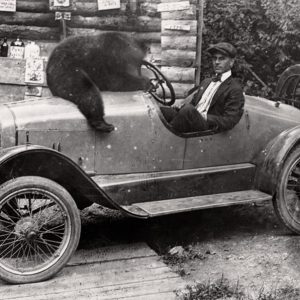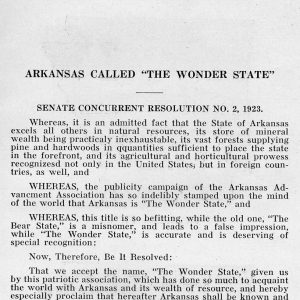calsfoundation@cals.org
Official State Nicknames
aka: State Nickname
Since the earliest days of statehood, Arkansas has been popularly known or designated by a succession of cognomens, or nicknames. The earliest were unofficial and reflected popular perceptions of a largely rural state, lightly tinged with humor. Later adoptions, spaced at intervals throughout the twentieth century, embodied less folk consciousness and more promotional intent, as Arkansas’s boosters sought to fine-tune the state’s image for outsiders’ consumption.
Arkansas’s earliest recorded nicknames, the “Bear State” and the “Toothpick State,” made reference to characteristic features of the region. In the first half of the nineteenth century, Arkansas was noted for its population of Louisiana black bears (Ursus americanus luteolus), one of sixteen black bear species found in the United States. Human activities reduced the population of native black bears to fewer than fifty by the middle of the twentieth century. The “Toothpick State” referenced the early custom of men carrying large sheath or belt knives, often double-edged dirks or daggers. The “toothpick” served as a common inexpensive sidearm and soon became fixed in the public imagination. The messy dispatching by knife of one Arkansas state representative by another in 1837 cemented the new state’s renown as a violent place.
One other early nickname for Arkansas deserves mention: “Rackensack.” The derivation of the word “Rackensack” has been analyzed with no single sure source ever identified, but by the end of the 1840s, it was established as a burlesque synonym for rural Arkansas, particularly the hills of the western part of the state. The name lives on, thanks to the Rackensack Folklore Society, the music-and-folk-culture society that took its name in the 1960s.
Arkansas did not acquire a formal or official nickname until 1923, when the legislative assembly recognized the activities of the Arkansas Advancement Association, a community of leading businessmen who sought to improve the state’s image and attract economic investment. The association’s most dynamic advocate was former governor Charles H. Brough, who traveled throughout the South and Midwest in the early 1920s, extolling the resources and attractions of what he dubbed “the wonder state.” In 1923, the association persuaded the Arkansas General Assembly to adopt formally the “Wonder State” as the state’s official nickname.
Though official, the nickname did little to change popular perceptions of Arkansas as an underdeveloped, even backward, state. The popularity in the 1930s of entertainers Bob Burns and “Lum and Abner,” whose stock in trade was Arkansas-referenced lowbrow humor, did little to dispel this image, and the state’s business and manufacturing sectors attracted little outside investment. In the early 1940s, a group of Little Rock (Pulaski County) businessmen known as the Committee of 100 began vigorous efforts to promote economic development and, consequently, stem the tide of outmigration in search of good jobs. Changing the state’s image was central to the group’s efforts. Committee of 100 promotional material referred to Arkansas as “Land of Opportunity,” a phrase more dynamic and perhaps less quaint than the older cognomen. In 1941, the tag phrase appeared for the first time on Arkansas auto license plates. In 1953, the Arkansas General Assembly took note of the committee’s efforts: House Concurrent Resolution 26 explicitly jettisoned “Wonder State,” noting that it did not “command the popular appeal that it once had,” and adopted “The Land of Opportunity” as Arkansas’s new nickname, alluding to a bright outlook for the development of business, industry, and agriculture.
During the 1980s, Arkansas’s outreach to tourists became more aggressive than before, reflecting a maturing understanding of tourism as a growth industry. In the mid-1980s, the Arkansas parks system began promoting Arkansas as “the Natural State” and the nickname proved popular, largely eclipsing the older “Land of Opportunity” in public esteem and currency. In 1995, Representative Dennis Young of Miller County introduced legislation to exchange the old nickname for the new one. Citing the state’s “unsurpassed scenery, clear lakes, free-flowing streams, magnificent rivers, meandering bayous, delta bottomlands, forested mountains and abundant fish and wildlife,” Act 1352 made official a change that had already largely been effected.
For additional information:
Ware, David. It’s Official! The Real Stories behind Arkansas’s State Symbols. 2nd ed. Little Rock: Butler Center Books, 2017.
Williams, C. Fred. “The Bear State Image: Arkansas in the Nineteenth Century.” Arkansas Historical Quarterly 39 (Summer 1980): 99–112.
Worthen, William B. “Arkansas and the Toothpick State Image.” Arkansas Historical Quarterly 53 (Summer 1994): 161–190.
David Ware
Arkansas Secretary of State’s Office
 Bear State
Bear State  Wonder State Resolution
Wonder State Resolution 



Comments
No comments on this entry yet.